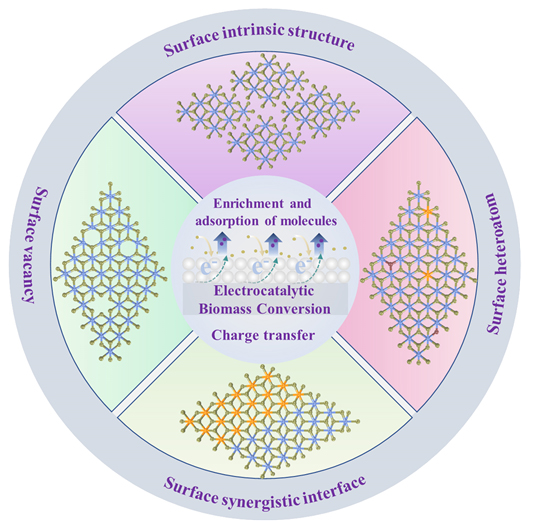摘要/Abstract

电催化生物质转化是以间歇式能源产生的电能驱动生物质电转化为高附加值有机化学品的过程,将其与水分解耦合能够产生高纯度氢气,具有有效降低化石燃料消耗、优化能源结构及解决环境问题的潜力.然而,由于生物质具有多个官能团及其转化反应涉及多个电子参与,电催化生物质转化面临着转化效率低、选择性差和稳定性不足等挑战.通过调控表面本征结构、构筑表面空位、引入表面杂原子和构建表面协同界面等一系列表界面化学工程对二维电催化材料进行设计和改性,实现对其表面电子结构和几何结构的优化,可以有效地改善二维材料的电转化效率、选择性和稳定性.本综述详细介绍了表界面化学改性二维材料电催化生物质转化的最新研究进展,总结了该研究领域存在的问题,并展望了其研究前景.
关键词: 电催化生物质转化, 表界面化学, 二维材料, 高附加值有机化学品, 氢气
Electrocatalytic biomass conversion, which utilizing the electrical energy generated by intermittent energy, drive biomass into high value-added organic chemicals, and usually can be coupled with water splitting for the production of high-purity hydrogen. It has the potential to significantly decrease fossil fuel consumption, optimize energy structure and solve environmental issues. However, because biomass possess multiple groups and its conversion involves multiple electrons, electrocatalytic biomass conversion suffer from low conversion efficiency, bad selectivity and poor stability. Surface and interface chemistry engineering, such as regulating intrinsic structure, generating vacancies, introducing heteroatom, and constructing synergistic interface, can design and modify two-dimensional electrocatalysts to optimize their electronic structure and geometric structure, and effectively improve the electrocatalytic efficiency, selectivity and stability. This review provides an overview of recent advances about the role of surface and interface chemistry played on electrocatalytic biomass conversion of two-dimensional materials. In addition, the authors also give some perspectives on the challenges and prospects in this field.
Key words: electrocatalytic biomass conversion, surface and interface chemistry, two-dimensional materials, high value-added organic chemicals, hydrogen
PDF全文下载地址:
点我下载PDF
